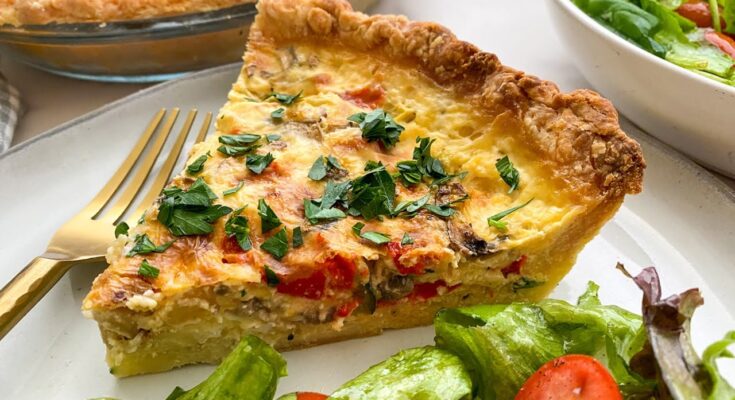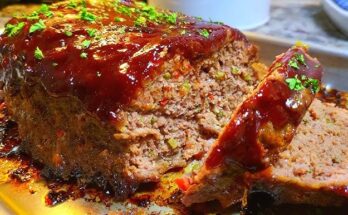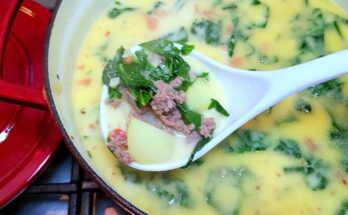Vegetable Quiche Recipe: There’s something incredibly comforting and satisfying about a warm slice of vegetable quiche. Whether it’s breakfast, brunch, lunch, or even a light dinner, this savory pie filled with veggies, cheese, and eggs offers everything you need in one delicious bite. In this step-by-step guide, I’m going to walk you through how to make the perfect vegetable quiche from scratch. Don’t worry—it’s easier than you think! With the right ingredients and a little preparation, you’ll have a golden, flavorful quiche that impresses everyone at the table.
Let’s get cracking (pun intended) and make a veggie-packed, cheese-laced masterpiece!
What is a Vegetable Quiche?
A quiche is essentially a savory, open-faced pie filled with a custard base of eggs and cream or milk, baked inside a pastry crust. What makes a vegetable quiche special is that it’s loaded with fresh, vibrant vegetables like spinach, bell peppers, onions, mushrooms, and tomatoes. You can add cheese, herbs, and even spices to give it more flavor. It’s incredibly versatile and can be served warm or cold, making it a fantastic make-ahead meal.
Quiche originated in France, with the most famous version being Quiche Lorraine (which includes bacon). The veggie version is a healthier, vegetarian-friendly twist that’s still packed with flavor. Whether you’re feeding a crowd or just looking for a comforting homemade dish, a vegetable quiche checks all the boxes.
Why Make a Quiche at Home?
Sure, you can pick up a frozen quiche or grab a slice at a café—but nothing compares to making it at home. Why? First of all, control. You choose exactly which veggies go in, what kind of cheese you use, how rich or light you want it to be, and whether you want a traditional crust or a gluten-free one.
Making it at home is also cost-effective. Let’s be honest, store-bought quiche can be overpriced. With some simple pantry ingredients, you can whip up a homemade version that tastes even better.
And then there’s the freshness factor. You can taste the difference when you’re using fresh ingredients. It’s also a great way to use up those veggies sitting in your fridge before they go bad. The bonus? Your kitchen will smell amazing.
Health Benefits of Vegetable Quiche
One of the best things about vegetable quiche is how easily it can be tailored to fit a health-conscious diet. Skip the heavy cream and opt for low-fat milk or a non-dairy alternative. Load it up with fiber-rich vegetables and heart-healthy olive oil instead of butter. You’re getting protein from the eggs and calcium from the cheese, plus antioxidants from the colorful veggie mix.
With so many customization options, you can keep it keto, gluten-free, vegetarian, or even dairy-free. It’s a dish that adapts to your health needs without compromising on flavor.
Ingredients You’ll Need
Before diving into the actual cooking process, let’s get our ingredients lined up. Having everything prepped and ready is key to a smooth experience in the kitchen. Here’s a breakdown of what you’ll need to make the perfect vegetable quiche:
Fresh Vegetables for the Filling
The heart of any vegetable quiche is, well, the vegetables! Go seasonal if you can, or just use what you already have. Here are some classic choices:
- Spinach – Fresh or frozen (thawed and drained). Adds a lovely earthy flavor.
- Bell Peppers – Red, yellow, or green for a sweet crunch.
- Mushrooms – Sliced button or cremini work well.
- Zucchini – Adds moisture and mild sweetness.
- Onions – Sautéed until caramelized for deep flavor.
- Tomatoes – Cherry or Roma, sliced thin to avoid excess moisture.
- Broccoli – Blanched and chopped into small florets.
You can mix and match depending on your taste and what’s in your fridge. Just remember to cook or sauté high-moisture veggies beforehand to avoid a soggy quiche.
Dairy Products and Eggs
This is what gives your quiche that creamy, rich texture:
- Eggs – You’ll need about 4-5 large eggs for a standard 9-inch quiche.
- Milk or Cream – Whole milk, half-and-half, or heavy cream. Want it lighter? Use low-fat milk or a non-dairy alternative like oat or almond milk.
- Cheese – Grated cheddar, Swiss, feta, mozzarella, or goat cheese. Cheese adds depth, saltiness, and that satisfying melty bite.
You can use a single type of cheese or combine two for extra flavor.
Spices, Herbs, and Seasonings
Don’t overlook your seasonings—they bring the whole dish to life:
- Salt & Pepper – Essential, of course.
- Garlic Powder or Minced Garlic – For that kick of flavor.
- Nutmeg – A tiny pinch makes the egg mixture sing.
- Dried or Fresh Herbs – Think thyme, basil, oregano, or parsley.
- Red Pepper Flakes (Optional) – If you like a little heat.
Use fresh herbs if you have them; dried ones work just as well in a pinch.
Pie Crust Options (Homemade vs. Store-Bought)
Your quiche’s foundation! You’ve got options:
- Store-Bought Pie Crust – A quick and easy route. Choose an all-butter crust for the best flavor.
- Homemade Pie Crust – If you’re feeling adventurous, a homemade crust with flour, butter, and cold water is unbeatable.
- Crustless Option – Going low-carb or gluten-free? Skip the crust entirely and just bake the filling in a greased dish.
You can also use a hash brown crust, quinoa crust, or almond flour base depending on your dietary needs or creativity.
Kitchen Tools You’ll Need
Essential Baking Tools
Before you get started with cooking, it’s helpful to know what tools you’ll need for a smooth and stress-free process. Making a quiche doesn’t require fancy equipment, but a few essentials are must-haves to get that perfect texture and crust.
Here’s what you’ll need:
- 9-inch pie pan or quiche dish – This is the classic size for quiches. You can also use a tart pan with a removable bottom if you want a more elegant presentation.
- Mixing bowls – One for the egg mixture and another for mixing the vegetables.
- Whisk – For beating the eggs and cream into a smooth custard base.
- Cutting board and sharp knife – Essential for chopping your vegetables evenly.
- Skillet or sauté pan – To cook down the vegetables before adding them to the quiche.
- Measuring cups and spoons – To get the perfect ratios for seasoning, eggs, and dairy.
- Oven mitts – Safety first! You’ll be pulling out a hot dish, so protect those hands.
These basic kitchen tools will help you move efficiently and ensure you don’t end up with lumpy eggs or raw veggies in your bake.
Recommended Optional Tools
While the essentials will get the job done, having these optional tools can elevate your cooking game and make the whole process even smoother:
- Food processor – Ideal for quickly prepping vegetables or making a homemade pie crust.
- Pastry brush – Perfect for brushing the crust with egg wash or butter for a golden finish.
- Cooling rack – Helps the quiche cool evenly once it comes out of the oven.
- Mandoline slicer – If you want uniformly thin slices of veggies like zucchini or tomatoes.
- Grater or microplane – For shredding cheese or adding a dusting of nutmeg or parmesan.
These aren’t required, but they do add a little efficiency and finesse. If you find yourself making quiches often, investing in some of these will be worth it.
Prepping for the Quiche
Prepping the Vegetables
This step is crucial. Quiche is all about balance, and the last thing you want is soggy vegetables or raw bits ruining the flavor and texture. Prepping your veggies properly ensures everything cooks evenly and tastes great.
Here’s how to prep like a pro:
- Wash and dry your vegetables thoroughly.
- Chop them into small, uniform pieces so they cook evenly.
- Sauté high-moisture veggies like mushrooms, spinach, zucchini, and onions in a pan with olive oil or butter. This not only enhances their flavor but removes excess moisture.
- Add a pinch of salt and pepper while cooking to bring out their natural flavors.
- If using frozen vegetables, thaw and drain them well before use. A cheesecloth or paper towels can help squeeze out excess water.
Properly cooked veggies not only prevent your quiche from becoming watery but also deepen the flavor in every bite.
Making or Prepping the Crust
If you’re using a store-bought crust, this part is easy. Just take it out of the freezer and let it thaw as directed on the packaging. You’ll often need to par-bake (pre-bake) it for 10–12 minutes at 375°F to ensure it doesn’t get soggy once filled.
For a homemade crust, here’s a quick summary:
- Ingredients: 1 1/4 cups all-purpose flour, 1/2 cup cold butter (cubed), 1/4 tsp salt, 3–5 tbsp ice water.
- Combine the flour and salt, then cut in the butter until crumbly.
- Add ice water slowly until dough comes together.
- Roll out the dough and place in your pie pan. Chill for 15 minutes.
- Par-bake for 10 minutes with pie weights or beans to prevent puffing.
Want to go crustless? Grease your pan with butter or oil and skip this step altogether.
Preparing the Egg and Dairy Mixture
This is the custard that holds everything together. The secret is in the ratio: about 1 part egg to 1 part milk or cream.
Here’s a basic guide:
- 4 large eggs
- 1 cup milk, cream, or half-and-half
- Optional: Add 1/4 cup sour cream or Greek yogurt for extra richness.
Whisk together in a bowl until completely smooth. Add your seasonings—salt, pepper, nutmeg, garlic powder, or herbs—at this stage. The key is to blend well, so every bite has the right balance of egg and flavor.
If you’re adding cheese to the filling (which you should!), you can mix it directly into the egg mixture or layer it between the vegetables in the crust.
Step-by-Step Cooking Instructions
Step 1 – Preheat and Prep the Oven
Preheat your oven to 375°F (190°C). If using a pie crust, line a 9-inch pie dish with it and prick the base with a fork. Pre-bake for 10 minutes to keep it crisp.
Step 2 – Sauté the Vegetables
In a skillet, heat olive oil and sauté onions, bell peppers, spinach, mushrooms, and zucchini until softened. Season with salt, pepper, and a pinch of herbs.
Step 3 – Assemble the Quiche
In a bowl, whisk eggs, milk or cream, and cheese. Stir in the cooked veggies, then pour the mixture into the crust.
Step 4 – Bake the Quiche to Perfection
Bake for 30–35 minutes until golden and set in the center.
Step 5 – Let It Cool and Serve
Allow to cool for 10 minutes before slicing. Serve warm or chilled—light, savory, and irresistibly creamy!
Tips for the Perfect Vegetable Quiche
Even though quiche is a relatively simple dish, a few smart tricks can make it turn out extra delicious every single time.
Avoiding Soggy Bottoms
No one likes a quiche with a soggy crust. Here’s how to prevent that culinary tragedy:
- Par-bake the crust: This gives the crust a head start and prevents it from absorbing too much moisture.
- Drain and sauté veggies: Vegetables like spinach, mushrooms, and zucchini contain a lot of water. Cook and cool them before adding to the crust.
- Sprinkle cheese on the bottom: A thin layer of grated cheese between the crust and the veggies can act as a moisture barrier.
- Let fillings cool before assembling: Hot veggies can steam the crust from the inside, so always cool them before adding.
Flavor Combinations to Try
While the classic medley of spinach, onions, and cheese is a winner, don’t be afraid to get creative with your quiche!
Some flavor combos worth trying:
- Mediterranean: Spinach, sun-dried tomatoes, feta, and olives.
- Southwestern: Bell peppers, black beans, corn, cheddar, and a pinch of cumin.
- Spring Veggie: Asparagus, leeks, peas, and goat cheese.
- Mushroom Lovers: A mix of wild mushrooms, caramelized onions, and Gruyère cheese.
- Garden Quiche: Use whatever is fresh and seasonal—zucchini, tomatoes, kale, even roasted eggplant.
Feel free to experiment. As long as you balance your egg-to-liquid ratio and cook your vegetables properly, the sky’s the limit!
Customizing for Dietary Needs
Quiche is a great dish for just about any dietary lifestyle. Here’s how you can tweak it to suit yours:
- Gluten-Free: Use a gluten-free crust or go crustless. There are even recipes that use shredded sweet potatoes or almond flour for the base.
- Dairy-Free: Swap dairy milk with almond, oat, or coconut milk and use dairy-free cheese or skip the cheese entirely.
- Low Carb / Keto: Ditch the crust and load up on eggs, cheese, and low-carb veggies like spinach, broccoli, or mushrooms.
- Vegan: Use a plant-based egg replacer and dairy-free milk. Add chickpea flour or tofu to help mimic the texture of eggs.
No matter your dietary preferences, there’s a quiche recipe out there for you. It’s all about finding the right balance that works for your taste and lifestyle.
Storing and Reheating Tips
One of the biggest advantages of quiche is that it stores incredibly well—so don’t be afraid to make a big one!
How to Store Leftover Quiche
Proper storage keeps your quiche fresh and safe to eat for days:
- Let the quiche cool completely before storing.
- Cover it tightly with plastic wrap or transfer to an airtight container.
- Store in the refrigerator for up to 4 days.
- For longer storage, you can freeze quiche. Wrap it tightly in foil and plastic wrap, and freeze for up to 2 months.
When freezing, you can either freeze it whole or slice it into individual portions for easy thaw-and-eat meals.
Best Reheating Methods
To reheat quiche and keep that flaky crust and soft filling, avoid the microwave when possible.
Here are the best methods:
- Oven: Preheat to 350°F (175°C), cover the quiche with foil, and bake for 15–20 minutes.
- Toaster Oven: Perfect for slices. Reheat uncovered at 350°F for 10–12 minutes.
- Microwave: Only if you’re in a rush. Heat individual slices on medium power for 1–2 minutes. Be aware the crust may get a little soft.
If frozen, allow the quiche to thaw overnight in the fridge before reheating for the best results.
Serving Suggestions
Quiche is as versatile in presentation as it is in ingredients. Here’s how to turn your quiche into a full meal or elegant spread.
What to Serve with Quiche
Depending on the occasion, you can keep it casual or go all-out:
- Fresh green salad: With a light vinaigrette, it’s the perfect contrast to the rich quiche.
- Fruit salad: Bright and refreshing, especially for breakfast or brunch.
- Roasted potatoes: For a hearty meal.
- Tomato soup: A cozy pairing, especially with cheese-heavy quiches.
- Crusty bread or croissants: For extra indulgence.
Brunch, Lunch, or Dinner Options
- Brunch: Serve with mimosas, fresh fruit, and a muffin tray. It’s always a hit.
- Lunch: Add a soup or side salad and serve cold or warm.
- Dinner: Pair with roasted vegetables or grilled asparagus and a chilled white wine.
Whatever time of day, quiche fits right in. Dress it up or down based on your mood and the meal.
FAQs about Vegetable Quiche Recipe
1. Can I freeze a vegetable quiche?
Yes! Once baked and cooled, wrap the quiche tightly in foil and plastic wrap. Store in the freezer for up to 2 months. Thaw overnight in the fridge before reheating in the oven.
2. What other vegetables can I use in a quiche?
Almost any vegetable works. Try asparagus, kale, eggplant, sweet potatoes, or even corn. Just be sure to sauté or roast them first to remove excess moisture and boost flavor.
3. Can I make quiche without dairy?
Absolutely! Use dairy-free milk alternatives like almond or oat milk, and swap out the cheese for vegan versions or skip it entirely. The egg mixture will still set beautifully.
4. How do I know when my quiche is done?
The center should be just set and slightly jiggly, not liquid. Insert a toothpick or knife into the center—if it comes out mostly clean, it’s ready. Let it rest before slicing.
5. Can I make this ahead of time?
Yes! Quiche can be made a day ahead. Bake, cool, and store in the fridge. Reheat before serving or enjoy it cold—it tastes great either way.
Conclusion
So there you have it—a complete, step-by-step guide to crafting the perfect vegetable quiche. With a flaky crust, creamy egg custard, and your favorite veggies tucked inside, quiche is one of those dishes that never goes out of style. It’s comforting, customizable, and works for any meal of the day. Whether you’re a kitchen novice or a seasoned home cook, this recipe is your gateway to quiche mastery.
Remember, don’t be afraid to make it your own. Swap ingredients, change up the spices, and try new flavor combos. Once you get the basics down, the possibilities are endless. So grab those eggs, fire up your oven, and start baking—your future self will thank you.


